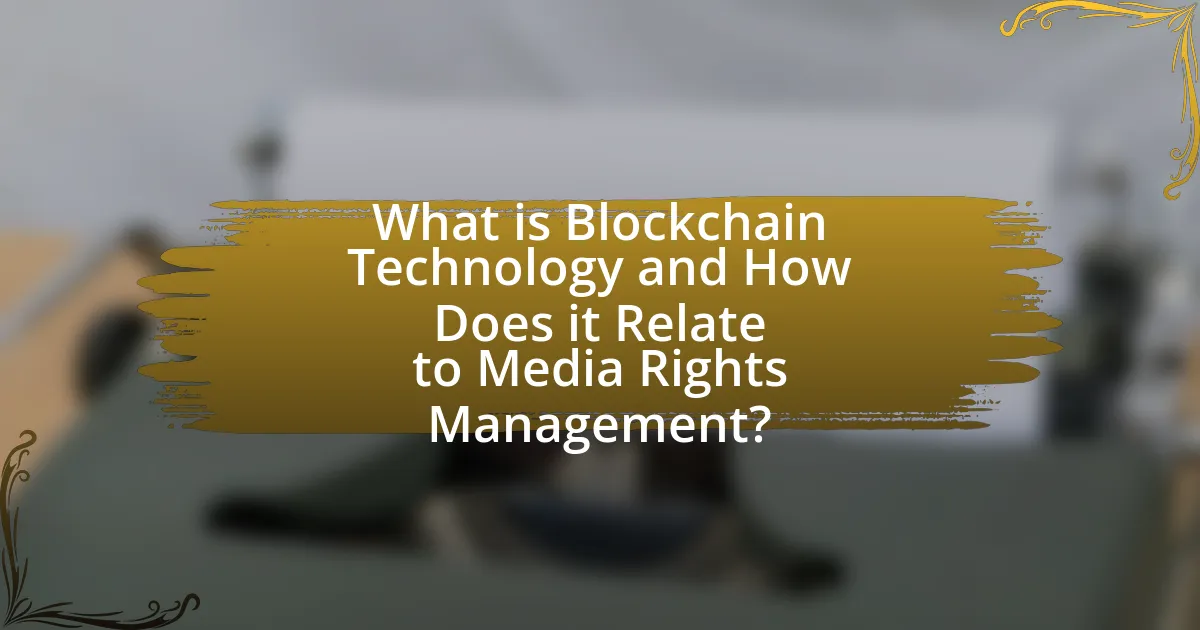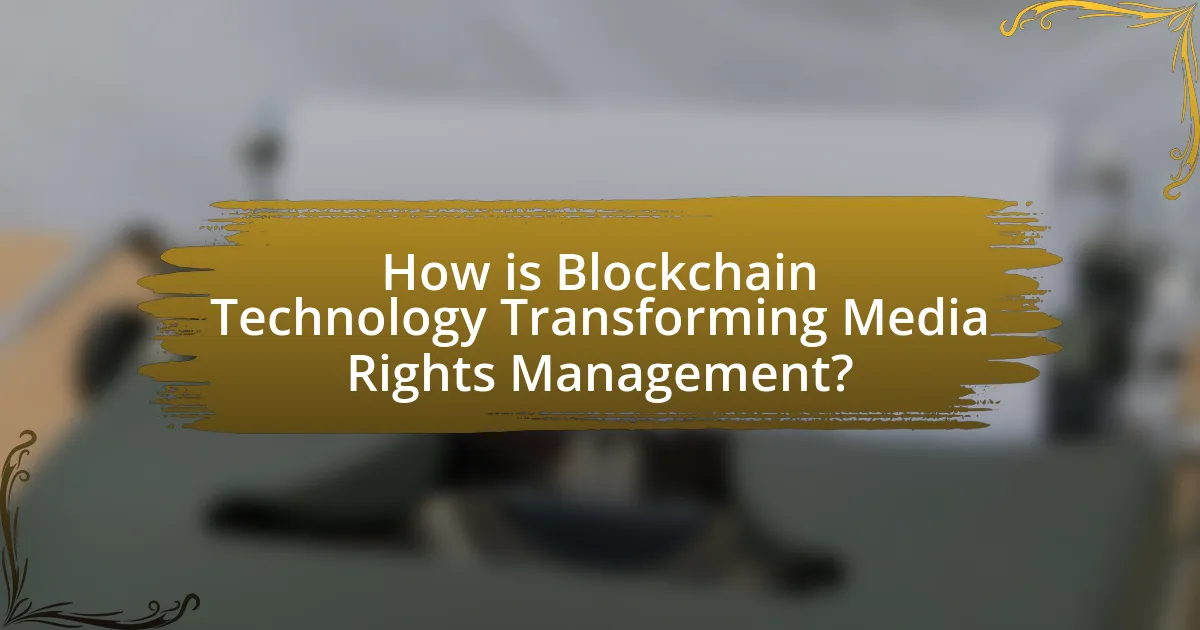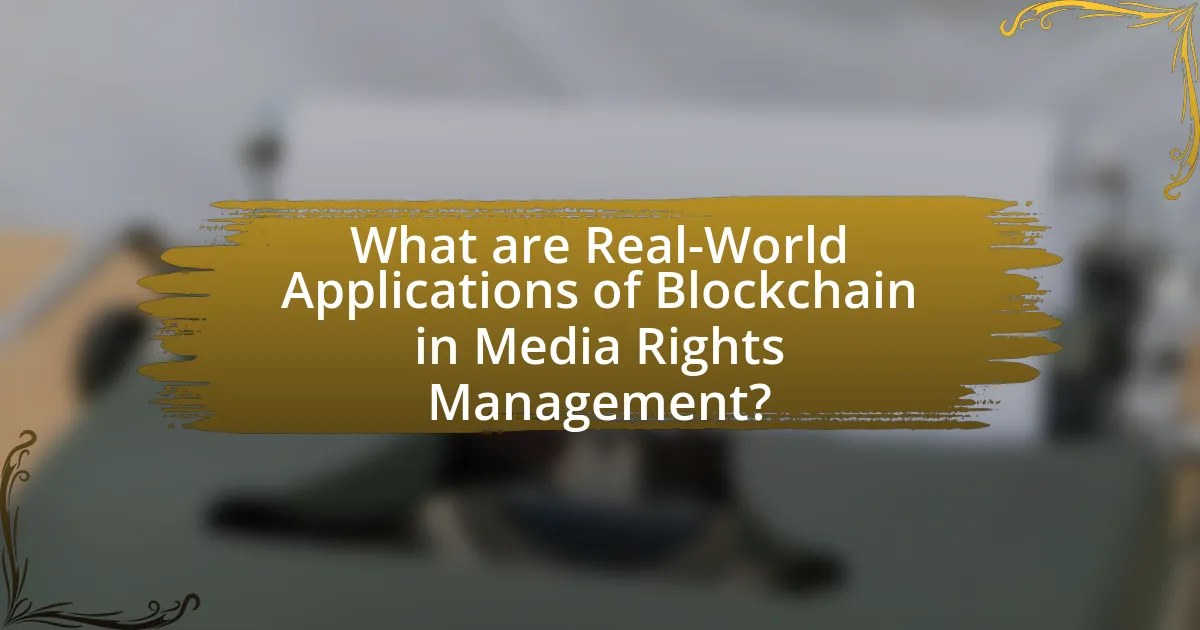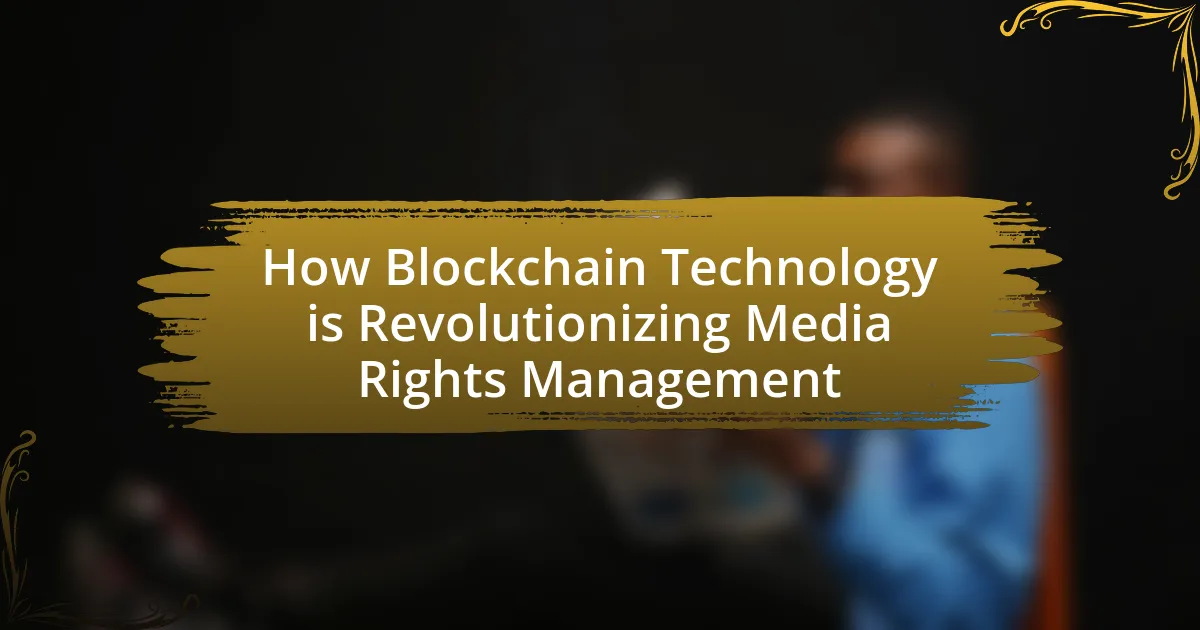Blockchain technology is a decentralized digital ledger that is transforming media rights management by providing a secure and transparent system for tracking ownership and usage rights of digital content. This article explores how blockchain enhances efficiency through features such as decentralization, immutability, and smart contracts, which automate royalty payments and reduce disputes. It also addresses the challenges faced by traditional media rights management systems, including inefficiencies and lack of transparency, and highlights real-world applications and case studies demonstrating successful blockchain implementations in the media industry. Additionally, the article discusses future trends, potential innovations, and best practices for organizations adopting blockchain technology in media rights management.

What is Blockchain Technology and How Does it Relate to Media Rights Management?
Blockchain technology is a decentralized digital ledger that securely records transactions across multiple computers, ensuring that the recorded data cannot be altered retroactively. In the context of media rights management, blockchain provides a transparent and immutable system for tracking ownership and usage rights of digital content, such as music, films, and artwork. This technology enables creators to register their works on the blockchain, allowing for real-time tracking of usage and automatic royalty payments through smart contracts. According to a report by Deloitte, blockchain can reduce transaction costs and increase efficiency in rights management by providing a single source of truth for all stakeholders involved, thus addressing issues of piracy and unauthorized use.
How does blockchain technology function in the context of media rights?
Blockchain technology functions in the context of media rights by providing a decentralized and transparent system for tracking ownership and usage rights of digital content. This technology enables creators to register their works on a blockchain, ensuring that their rights are immutable and easily verifiable. For instance, platforms like Myco and Ujo Music utilize blockchain to allow artists to manage their rights directly, facilitating fair compensation through smart contracts that automatically distribute royalties based on usage. The transparency of blockchain also reduces disputes over ownership, as all transactions are recorded in a public ledger, making it easier to trace the history of a media asset.
What are the key features of blockchain that enhance media rights management?
The key features of blockchain that enhance media rights management include decentralization, transparency, immutability, and smart contracts. Decentralization allows for a distributed ledger that eliminates the need for a central authority, reducing the risk of fraud and manipulation. Transparency ensures that all transactions are visible to authorized parties, fostering trust among stakeholders. Immutability guarantees that once data is recorded on the blockchain, it cannot be altered or deleted, providing a reliable record of ownership and rights. Smart contracts automate the execution of agreements, ensuring that rights holders receive payments automatically when their content is used, thus streamlining the management process. These features collectively improve the efficiency and security of media rights management, as evidenced by various implementations in the industry that have demonstrated reduced disputes and faster transactions.
How does decentralization impact the management of media rights?
Decentralization significantly enhances the management of media rights by distributing control among multiple stakeholders rather than centralizing it in a single entity. This shift allows for greater transparency, as blockchain technology enables all transactions and rights ownership to be recorded on an immutable ledger, reducing the risk of fraud and disputes. For instance, the use of smart contracts automates the enforcement of rights agreements, ensuring that creators receive fair compensation in real-time when their content is used. Additionally, decentralization fosters a more equitable ecosystem, empowering independent creators and smaller entities to negotiate directly with consumers, thus bypassing traditional intermediaries that often take a substantial cut of revenues. This transformation is evidenced by platforms like Audius, which leverage blockchain to allow artists to manage their own rights and earnings directly.
Why is media rights management important in the digital age?
Media rights management is crucial in the digital age because it ensures the protection and monetization of intellectual property in an environment characterized by rapid content sharing and distribution. The proliferation of digital platforms has made it easier for content to be copied and disseminated without proper authorization, leading to significant revenue losses for creators and rights holders. According to a report by the International Intellectual Property Alliance, piracy costs the U.S. economy billions annually, highlighting the need for effective rights management strategies. Furthermore, advancements in technology, such as blockchain, provide innovative solutions for tracking ownership and usage rights, thereby enhancing transparency and trust in media transactions. This technological integration is essential for safeguarding creators’ rights and ensuring fair compensation in a digital landscape where content is easily accessible.
What challenges do traditional media rights management systems face?
Traditional media rights management systems face significant challenges, including inefficiencies in tracking ownership and usage rights. These systems often rely on outdated databases and manual processes, leading to errors and disputes over rights ownership. Additionally, the lack of transparency in traditional systems makes it difficult for creators to verify how their content is being used and compensated. According to a report by the World Intellectual Property Organization, approximately 30% of copyright disputes arise from unclear rights management, highlighting the need for more effective solutions. Furthermore, traditional systems struggle with scalability, as they cannot easily adapt to the rapid growth of digital content and the complexities of global distribution.
How can blockchain address these challenges?
Blockchain can address challenges in media rights management by providing a decentralized and transparent system for tracking ownership and usage rights. This technology enables immutable record-keeping, ensuring that all transactions related to media assets are securely documented and easily verifiable. For instance, smart contracts can automate royalty payments based on predefined conditions, reducing disputes and ensuring timely compensation for creators. Additionally, blockchain’s ability to create unique digital identifiers for each media asset helps prevent unauthorized use and piracy, as ownership can be traced back to the original creator. These features collectively enhance trust and efficiency in the management of media rights.

How is Blockchain Technology Transforming Media Rights Management?
Blockchain technology is transforming media rights management by providing a decentralized and transparent system for tracking ownership and usage rights. This technology enables creators to register their works on a blockchain, ensuring that their intellectual property is securely documented and easily verifiable. For instance, platforms like Myco and Ujo Music utilize blockchain to facilitate direct transactions between artists and consumers, eliminating intermediaries and ensuring that creators receive fair compensation. Additionally, smart contracts automate royalty payments, reducing disputes and ensuring timely distribution of earnings. The immutable nature of blockchain records enhances trust among stakeholders, as all transactions are publicly accessible and cannot be altered retroactively.
What are the primary benefits of using blockchain for media rights management?
The primary benefits of using blockchain for media rights management include enhanced transparency, improved security, and streamlined royalty distribution. Blockchain technology allows all transactions and rights ownership to be recorded on a decentralized ledger, making it easy for stakeholders to verify rights and ownership without intermediaries. This transparency reduces disputes over rights ownership and usage, as all parties can access the same information in real-time. Additionally, the security features of blockchain protect against unauthorized access and fraud, ensuring that media assets are safeguarded. Finally, smart contracts on the blockchain automate royalty payments, ensuring that creators receive their earnings promptly and accurately, which can significantly reduce administrative costs and delays in payment processing.
How does blockchain improve transparency in media rights transactions?
Blockchain improves transparency in media rights transactions by providing an immutable and decentralized ledger that records all transactions in real-time. This technology allows all parties involved, including creators, distributors, and consumers, to access a single source of truth regarding ownership and rights usage. Each transaction is time-stamped and linked to previous transactions, making it easy to trace the history of rights ownership and usage. For instance, a study by the World Economic Forum highlights that blockchain can reduce disputes over rights ownership by ensuring that all changes are recorded transparently and are verifiable by all stakeholders. This level of transparency fosters trust among parties and reduces the potential for fraud or misrepresentation in media rights transactions.
What role does smart contracts play in media rights management?
Smart contracts play a crucial role in media rights management by automating and enforcing agreements between content creators and distributors. These self-executing contracts, built on blockchain technology, ensure that rights are accurately tracked and that payments are automatically processed upon the fulfillment of predefined conditions. For instance, smart contracts can facilitate real-time royalty payments to artists based on usage data, eliminating delays and reducing the risk of disputes. This automation enhances transparency and trust in the media ecosystem, as all parties can verify transactions on the blockchain, which is immutable and publicly accessible.
What are the potential drawbacks or limitations of blockchain in this field?
The potential drawbacks or limitations of blockchain in media rights management include scalability issues, high energy consumption, and regulatory uncertainty. Scalability is a concern as blockchain networks can struggle to handle a large volume of transactions efficiently; for instance, Ethereum has faced congestion during peak usage times, leading to slower transaction speeds and higher fees. High energy consumption is another limitation, particularly with proof-of-work systems, which can be detrimental to the environment and raise sustainability concerns. Additionally, regulatory uncertainty poses challenges, as the legal status of blockchain technology and smart contracts remains ambiguous in many jurisdictions, potentially hindering widespread adoption and integration into existing legal frameworks.
How does scalability affect blockchain’s application in media rights management?
Scalability significantly impacts blockchain’s application in media rights management by determining the network’s ability to handle a large volume of transactions efficiently. High scalability allows for quick processing of numerous rights transactions, which is essential in a dynamic media environment where content is frequently created, distributed, and consumed. For instance, Ethereum, a popular blockchain platform, has faced scalability challenges, leading to slower transaction times and higher fees during peak usage, which can hinder its effectiveness in managing media rights. In contrast, scalable solutions like Layer 2 protocols or alternative blockchains designed for high throughput can facilitate real-time updates and transactions, thereby enhancing the management of media rights and ensuring that creators receive timely compensation for their work.
What are the legal implications of using blockchain for media rights?
The legal implications of using blockchain for media rights include issues related to copyright enforcement, contract execution, and data privacy. Blockchain technology enables immutable record-keeping, which can enhance the enforcement of copyright by providing a transparent and verifiable history of ownership and usage rights. This transparency can reduce disputes over rights ownership, as all transactions are recorded on a public ledger. Additionally, smart contracts on blockchain can automate licensing agreements, ensuring that terms are executed as intended without the need for intermediaries, thereby streamlining the process and reducing legal complexities. However, the use of blockchain also raises concerns regarding compliance with data protection regulations, such as the General Data Protection Regulation (GDPR), particularly in relation to the right to be forgotten, as data on a blockchain is typically permanent and cannot be easily altered or deleted.

What are Real-World Applications of Blockchain in Media Rights Management?
Real-world applications of blockchain in media rights management include the tracking of ownership and usage rights for digital content, enabling transparent royalty distribution, and facilitating smart contracts for licensing agreements. For instance, platforms like Myco and Ujo Music utilize blockchain to ensure artists receive fair compensation by automatically distributing royalties based on predefined conditions encoded in smart contracts. Additionally, the use of blockchain allows for immutable records of ownership, which helps prevent copyright infringement and unauthorized use of media assets. These applications demonstrate how blockchain technology enhances efficiency, transparency, and trust in the management of media rights.
How are companies currently implementing blockchain for media rights management?
Companies are currently implementing blockchain for media rights management by utilizing decentralized ledgers to track ownership and usage rights of digital content. This technology enables transparent and immutable records of transactions, allowing creators and rights holders to manage their intellectual property more effectively. For instance, platforms like Myco and MediaChain are leveraging blockchain to create a secure environment for artists to register their works, ensuring that royalties are distributed fairly and promptly based on actual usage data. Additionally, the integration of smart contracts automates licensing agreements, reducing administrative overhead and minimizing disputes over rights. These implementations demonstrate a shift towards more efficient and equitable management of media rights in the digital landscape.
What case studies illustrate successful blockchain applications in media rights?
Successful blockchain applications in media rights are illustrated by case studies such as the partnership between the media company MediaChain and the music industry, which utilized blockchain to ensure transparent royalty distribution. This collaboration allowed artists to receive payments directly and in real-time, significantly reducing delays associated with traditional systems. Another notable example is the use of blockchain by the film industry, where companies like SingularDTV have implemented smart contracts to manage rights and revenue sharing, ensuring that all stakeholders are compensated fairly and promptly. These case studies demonstrate how blockchain technology enhances transparency, efficiency, and trust in media rights management.
How do these implementations affect stakeholders in the media industry?
Implementations of blockchain technology in media rights management significantly enhance transparency and efficiency for stakeholders in the media industry. By utilizing decentralized ledgers, content creators, distributors, and consumers can track ownership and usage rights in real-time, reducing disputes and ensuring fair compensation. For instance, a study by the World Economic Forum indicates that blockchain can streamline royalty payments, potentially increasing revenue for artists by up to 30% due to reduced administrative costs and faster transactions. This shift not only empowers creators but also fosters trust among consumers and distributors, ultimately transforming the economic landscape of the media industry.
What future trends can we expect in blockchain and media rights management?
Future trends in blockchain and media rights management include increased transparency, enhanced security, and the rise of decentralized platforms. As blockchain technology matures, it will enable real-time tracking of media rights ownership and usage, reducing disputes and ensuring fair compensation for creators. Additionally, smart contracts will automate licensing agreements, streamlining the process and minimizing administrative costs. According to a report by Deloitte, the integration of blockchain in media rights management can potentially save the industry billions by eliminating inefficiencies and fraud.
How might emerging technologies integrate with blockchain for media rights?
Emerging technologies such as artificial intelligence (AI), the Internet of Things (IoT), and augmented reality (AR) can integrate with blockchain to enhance media rights management by providing automated, transparent, and secure processes. AI can analyze and manage rights data efficiently, ensuring that content creators receive fair compensation through smart contracts on the blockchain, which automatically execute payments based on usage metrics. IoT devices can track content distribution in real-time, feeding data back to the blockchain to maintain an accurate record of rights ownership and usage. Additionally, AR can create immersive experiences that require precise rights management, which blockchain can facilitate by verifying ownership and licensing in a decentralized manner. This integration not only streamlines the management of media rights but also increases trust among stakeholders by providing an immutable record of transactions and rights ownership.
What innovations are on the horizon for blockchain in the media sector?
Innovations on the horizon for blockchain in the media sector include enhanced rights management, decentralized content distribution, and improved transparency in royalty payments. These advancements aim to streamline the process of tracking ownership and usage rights, allowing creators to maintain control over their work while ensuring fair compensation. For instance, platforms like Audius utilize blockchain to enable artists to distribute music directly to fans, bypassing traditional intermediaries. Additionally, projects such as Myco aim to provide transparent royalty tracking through smart contracts, ensuring that artists receive payments in real-time based on actual usage data. These innovations are supported by the growing adoption of blockchain technology, which is projected to reach a market value of $163 billion by 2027, indicating a significant shift in how media rights are managed and monetized.
What best practices should organizations follow when adopting blockchain for media rights management?
Organizations should follow best practices such as ensuring data integrity, establishing clear governance frameworks, and fostering collaboration among stakeholders when adopting blockchain for media rights management. Ensuring data integrity involves using cryptographic techniques to secure and verify ownership and usage rights, which enhances trust and transparency in transactions. Establishing clear governance frameworks is essential for defining roles, responsibilities, and decision-making processes, which helps in managing disputes and compliance with regulations. Fostering collaboration among stakeholders, including content creators, distributors, and consumers, encourages a shared understanding of rights and responsibilities, ultimately leading to more efficient and effective rights management. These practices are supported by successful implementations in various industries, demonstrating the potential of blockchain to streamline processes and reduce conflicts in media rights management.

Leave a Reply